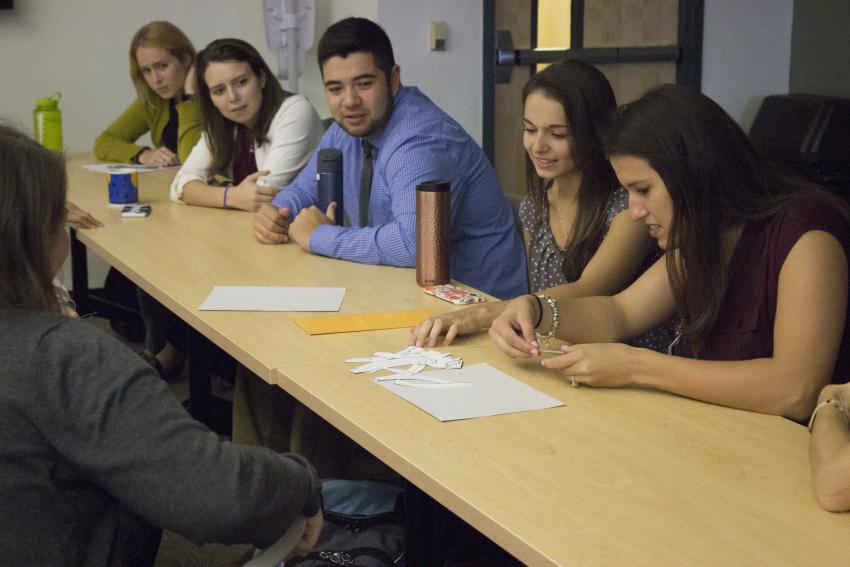Hands-on Exercises Help Prepare College of Health Science Students for Career Work

By Marcella Haddad ’17
“It seems like you have a pretty strong history of colon cancer,” said Genetic Counseling student John Lewis, looking through his notes.
The patient nodded and looked down at his hands.
Fortunately, this was only an exercise; the patient, an actor. But the exercise was instrumental for the Arcadia University students in the College of Health Sciences, as they would soon be dealing with such health-care related scenarios in their careers.
During six Friday mornings in October and November, the College of Health Sciences transformed the second floor of Brubaker Hall into patient rooms. All of the students from Genetic Counseling, Physician’s Assistant, Physical Therapy, and many of the students from Public Health participated in an interprofessional event created by faculty from the four disciplines.
The October sessions began with a jigsaw puzzle, where students, working in groups of 10 comprised from each discipline, put together job names and descriptions of the other areas of study within the health sciences. Then, each group went into a room with a standardized patient actor, where the represented professions interacted with the patient and observed what the other disciplines did. In the November sessions, the students will meet the standardized patient who have just undergone surgery for the colon cancer. This will be another opportunity for the students to understand the role that each of the health care professionals play in ensuring a quality health care experience for the patient.
Faculty members in the College of Health Sciences noted how valuable it is to rehearse these situations, especially when working alongside so many others.
“Patient care is important, and it’s important for [the students] to know what each other does so that they can improve recommendations and the patient experience,” said Dr. Laura Conway, associate professor of Genetic Counseling. “The health professions have to work together, but they are rarely in the same room together in actual practice.”
The students determined who from each group would take the lead and ask questions. Dr. Katie DiSantis, assistant professor of Public Health, facilitated one of the simulations. She reminded students before they went in that “this is a safe environment to critique each other in order to improve patient care.”
As students sat in a circle of chairs around the patient, the leaders took turns asking questions from the standpoint of the different disciplines, starting with Lewis. Physician Assistant student Michael McDaniel asked about symptoms and pain; Physical Therapy student Alyssa Lawson asked about the patient’s mobility, and what he would like to get back to doing after the surgery; and Public Health/Counseling/Psychology student Tina Kocol inquired about his support system.
At the end, Dr. DiSantis asked the student leaders how they felt the exercise went before offering her thoughts and critique. The patient gave feedback on how he thought the students did, while other students shared what they had observed and learned about the other professions.
Some students described their nervousness going into the simulation, but Dr. DiSantis complimented them on their warm and welcoming demeanor. “We’re professionals, but we’re also humans, working with humans,” she reminded them.
This is the second interprofessional exercise College of Health Sciences faculty have coordinated in an effort to “thread” the programs together, Dean of the College of Health Sciences Rebecca Craik said. In August, students and faculty from the College of Health Science programs traveled to Belize to assist with interprofessional health and nutrition care. Additionally, several faculty members attended the Interprofessional Education Collaboration (IPEC) to further develop interprofessional programs.


